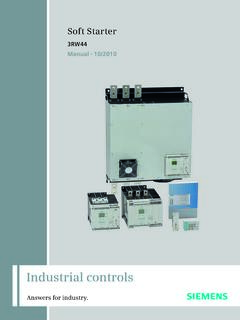Transcription of When to use a Soft Starter or an AC Variable Frequency Drive
1 White PaperWhen to use a soft Starter or an AC Variable Frequency DriveProduct lines: Smart Motor Controllers (SMCs), AC Variable Frequency Drives (VFDs)Additional ResourcesThese documents contain additional information concerning related products from Rockwell can view or download publications at To order paper copies of technical documentation, contact your local Allen-Bradley distributor or Rockwell Automation sales picPageIntroduction2 Starting Methods3 How does a VFD work? 7 Comparisons 8 Wye-delta (Starting Inside the Delta)
2 Motors11 Communication Capabilities for Monitoring and Control11 Harmonics, Wiring Methods and Installation Considerations12 Starting and stopping time accuracy12 Speed control 13 Full torque at 0 speed14 Initial Cost15 Physical Size15 Maintenance16 Starting and Stopping Options17 Applications and Motors19 Summary20 ResourceDescriptionIndustrial Automation Wiring and Grounding Guidelines, publication general guidelines for installing a Rockwell Automation industrial Certifications website, declarations of conformity, certificates, and other certification Automation Publication 150-WP007A-EN-P - October 2014 when to use a soft Starter or an AC Variable Frequency DriveIntroductionA common question when deciding between a soft Starter or a Drive is, which one to select?
3 The purpose of this publication is to show similarities and differences between the soft Starter and the Drive . when comparing the two devices, you should be able to pick the best device for the application. Many comparisons are done using Allen-Bradley Smart Motor Controllers (SMCs) and AC Variable Frequency drives (VFDs). While the question is simple, the answer is not. If you examine the function and purpose of the soft Starter and Drive , the answer becomes clearer. Generally, the application determines the best fit.
4 Common questions to ask are: Does the application need full torque at zero speed? Does the application need speed control once the motor is at speed? Does the application need constant torque? Does the application need precise starting and stopping times? Is space a consideration?This publication helps explain some of the differences, and when to choose one type of controller over this paper, the terms Drives and VFD are used interchangeably. Star-Delta and Wye-Delta are used interchangeably. Silicon-controlled rectifier ( SCR ) and thyristor are used interchangeably.
5 So when do you use a soft Starter instead of a Drive ?Here are some common applications of each: soft Starters Applications with low or medium starting torque Lightly loaded applications Little or no speed control during run mode Reduce mechanical wear and damage to system Controlling inrush Power monitoringRockwell Automation Publication 150-WP007A-EN-P - October 20143 when to use a soft Starter or an AC Variable Frequency Drive Drive Single-phase applications on certain drives Speed control and system efficiencies operating at reduced speeds during the run mode Applications with high
6 Starting torque Continuous feedback for critical position control Holding rotor at zero speed Reduce mechanical wear and damage to system Starting MethodsFigure 1 - Starting Method ComparisonHow does a Direct On Line (DOL) Starter work?As a basic starting method, a DOL (or Across-The-Line ) Starter applies full voltage, current, and torque immediately to the motor once a start command is provided. Normally, power is immediately removed once the stop signal is given. On and Off are the only two states of this method.
7 Optional smart overloads can add complexity to the Starter and feedback from the Starter . Figure 2 shows the typical NEMA Design B or IEC Class N motor torque and speed Protection DeviceOptional IsolationContactorSoft StarterM3 Short-Circuit Protection DeviceDirect-on-LineStarterM3 Short-Circuit Protection DeviceVariableFrequencyDriveAC/DC/ACConv erterOverload RelayContactor4 Rockwell Automation Publication 150-WP007A-EN-P - October 2014 when to use a soft Starter or an AC Variable Frequency DriveFigure 2 - Full-voltage Starting Torque/Speed CurveHow does a soft Starter work?
8 An algorithm controlling three pairs of back to back SCRs are used to start and stop the motor. The back to back orientation of the SCRs allows the AC voltage to be controlled by changing the firing angle every half cycle (Figure 4). Voltage is either ramped up to full voltage, or is limited to provide current limit starts. Figure 3 - Basic Motor with SCR~6x FLAT orque180%100%0100%Speed % RPMM otorRockwell Automation Publication 150-WP007A-EN-P - October 20145 when to use a soft Starter or an AC Variable Frequency Drive Figure 4 - Different Firing Angles (Single-Phase Simplification)A soft Starter uses voltage to control the current and torque.
9 The motor torque is approximately proportional to the square of the applied voltage. % Torque %Voltage2 Given this relationship, a 60% reduction in the applied voltage results in approximately an 84% reduction in generated torque. In this example, 40% voltage is used. ( )2 = , or 16% of Locked Rotor Torque is current during the start is directly related to the voltage applied to the motor. Ta b l e 1 shows starting methods of a full voltage, wye-delta (or star-delta), and a soft Starter . Notice the reduction in starting torque in comparison to the starting voltage.
10 A standard Wye-Delta start with contactors is achieved with current limit set to 350%, or starting torque set to 34% on the soft (Applied)=Current (Drawn)Voltage (Maximum)Current (Maximum)SupplyVoltageFiring RMSV oltage Firing for25% RMSV oltage Firing for100% RMSV oltage 6 Rockwell Automation Publication 150-WP007A-EN-P - October 2014 when to use a soft Starter or an AC Variable Frequency DriveTable 1 - Type of Start, Voltage, Torque, and CurrentFigure 5 - Back-to-Back SCR ConfigurationFigure 5 shows back-to-back SCR configuration of the soft Starter in line connected mode.













